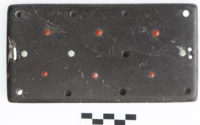 A belt buckle that would make a rodeo winner feel inadequate has been unearthed from a Bronze Age grave in the Tuva Republic of the Russian Federation. The plaque is seven inches long and 3.5 inches wide and made of jet inlaid with turquoise, carnelian and mother of pearl in a dot pattern. On one side of the buckle are two round perforations used to tie it to the belt; the other side has a single oval perforation that was likely used to fasten the belt. The belt was decorated with Chinese wuzhu coins which indicate it is up to 2,137 years old.
A belt buckle that would make a rodeo winner feel inadequate has been unearthed from a Bronze Age grave in the Tuva Republic of the Russian Federation. The plaque is seven inches long and 3.5 inches wide and made of jet inlaid with turquoise, carnelian and mother of pearl in a dot pattern. On one side of the buckle are two round perforations used to tie it to the belt; the other side has a single oval perforation that was likely used to fasten the belt. The belt was decorated with Chinese wuzhu coins which indicate it is up to 2,137 years old.
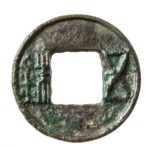 It was discovered in a 2016 excavation of the Ala-Tey 1 cemetery, located at the foot of the Ala-Tey mountain and, thanks to the the Sayan-Shushenskoe Dam, 55 feet under water at the bottom of a 240 square-mile reservoir. Excavation is only possible a few weeks a year in May and June when melt-water is run off and the whole reservoir becomes a desolate expanse of sand. As luck would have it, archaeologists only discovered the subterranean cemetery because of these unique conditions. The top layer of sand covering the graves was washed off by the water, exposing stone slabs and cyst graves that otherwise would have been completely invisible in the landscape.
It was discovered in a 2016 excavation of the Ala-Tey 1 cemetery, located at the foot of the Ala-Tey mountain and, thanks to the the Sayan-Shushenskoe Dam, 55 feet under water at the bottom of a 240 square-mile reservoir. Excavation is only possible a few weeks a year in May and June when melt-water is run off and the whole reservoir becomes a desolate expanse of sand. As luck would have it, archaeologists only discovered the subterranean cemetery because of these unique conditions. The top layer of sand covering the graves was washed off by the water, exposing stone slabs and cyst graves that otherwise would have been completely invisible in the landscape.
 The area was a crossroads of trade and migration for centuries, and graves and cemeteries from a number of different Bronze Age peoples have been unearthed there. One of them, the nomadic Xiongnu people, built a regional empire in the 3rd-2nd century B.C. strong enough to pose a significant threat to Han China.
The area was a crossroads of trade and migration for centuries, and graves and cemeteries from a number of different Bronze Age peoples have been unearthed there. One of them, the nomadic Xiongnu people, built a regional empire in the 3rd-2nd century B.C. strong enough to pose a significant threat to Han China.
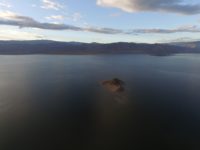 Ala-Tey 1 was discovered in 2014 in an archaeological survey of the site during that 3-4 week window when the reservoir is empty. Excavations found that it was Xiongnu cemetery, unique in that it appeared to be undamaged and unlooted. It was also compact, the graves grouped more closely together than the other Xiongnu burial ground in the area (Terezin, on the eroded shores of the reservoir) making it possible to systematically explore it even the very brief yearly gap between the run-off and refilling of the reservoir.
Ala-Tey 1 was discovered in 2014 in an archaeological survey of the site during that 3-4 week window when the reservoir is empty. Excavations found that it was Xiongnu cemetery, unique in that it appeared to be undamaged and unlooted. It was also compact, the graves grouped more closely together than the other Xiongnu burial ground in the area (Terezin, on the eroded shores of the reservoir) making it possible to systematically explore it even the very brief yearly gap between the run-off and refilling of the reservoir.
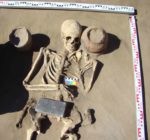 Since excavations of Ala-Tey 1 began, more than 100 burials have been unearthed. Because its lack of visible elements over the graves and the featureless sandy surface kept the cemetery safe from ancient looters, the remains found there are crucial to our understanding of Xiongnu funerary practices and social structure. The only surviving historical accounts of the Xiongnu people come from Chinese chroniclers, and at best they were looking from the outside in, so archaeological remains are invaluable in confirming or denying the known accounts.
Since excavations of Ala-Tey 1 began, more than 100 burials have been unearthed. Because its lack of visible elements over the graves and the featureless sandy surface kept the cemetery safe from ancient looters, the remains found there are crucial to our understanding of Xiongnu funerary practices and social structure. The only surviving historical accounts of the Xiongnu people come from Chinese chroniclers, and at best they were looking from the outside in, so archaeological remains are invaluable in confirming or denying the known accounts.
 One notable distinction, seen in the 2016 find as well, is the difference in grave goods. None of the male graves unearthed so far include elaborate adornments like the large buckles and highly decorative appliques, only utilitarian objects (pottery, iron knives) and very rarely weapons (only one of the 90 graves had arrowheads}. Female burials are richer, often featuring precious jewelry, Chinese mirrors, and the highly characteristic belts with large jet or bronze buckles. The central plaque when made of jet is often festooned with
One notable distinction, seen in the 2016 find as well, is the difference in grave goods. None of the male graves unearthed so far include elaborate adornments like the large buckles and highly decorative appliques, only utilitarian objects (pottery, iron knives) and very rarely weapons (only one of the 90 graves had arrowheads}. Female burials are richer, often featuring precious jewelry, Chinese mirrors, and the highly characteristic belts with large jet or bronze buckles. The central plaque when made of jet is often festooned with 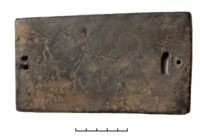 semiprecious stones as in the jet plaque from grave AT1/29, or engraved with zoomorphic images or geometric designs. The bronze buckles have complex openwork designs, for example two horses in combat, four snakes whose curves look like a geometric pattern, purely geometric latticework, two bulls with lowered heads, two camels looking at each other, etc.
semiprecious stones as in the jet plaque from grave AT1/29, or engraved with zoomorphic images or geometric designs. The bronze buckles have complex openwork designs, for example two horses in combat, four snakes whose curves look like a geometric pattern, purely geometric latticework, two bulls with lowered heads, two camels looking at each other, etc.
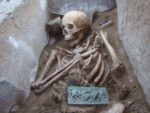 The belts, made of leather or textiles, have not survived, but in addition to the central plaques, edge decorations of bronze, stone, shells, beads, bronze bells and bronze Chinese coins ran all the way around them. These belts must have been very heavy and musical in movement. They’ve always been found around the waist of the woman, and there’s evidence of wear on the jet plaques, so it seems the belts weren’t just grave goods, but were actually worn in life. It’s probable
The belts, made of leather or textiles, have not survived, but in addition to the central plaques, edge decorations of bronze, stone, shells, beads, bronze bells and bronze Chinese coins ran all the way around them. These belts must have been very heavy and musical in movement. They’ve always been found around the waist of the woman, and there’s evidence of wear on the jet plaques, so it seems the belts weren’t just grave goods, but were actually worn in life. It’s probable 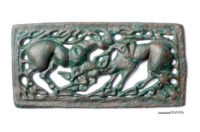 they were ceremonial pieces saved for special occasions like weddings and buried with their owners as their most precious adornment. It could be indicative of an elevated position in society held by Xiongnu women, or it could simply be a reflection of women having far more elaborate ceremonial attire than the men.
they were ceremonial pieces saved for special occasions like weddings and buried with their owners as their most precious adornment. It could be indicative of an elevated position in society held by Xiongnu women, or it could simply be a reflection of women having far more elaborate ceremonial attire than the men.
Some silly people are posting the picture and saying it is a cell phone, lol.
Very nice buckles, but instead that would be, what I call a belt.
Also, what about this one?
On the jet buckle with the mountain goats (I believe this is actually a Ibex), you can see arrows scratched into possible strategic kill locations of the goats. Maybe a teaching aid for the kids? On the lower right of the buckle, you can see maybe a crude bow and arrow.
Also the horse depicted, it’s rear haunches are splayed backwards opposite of the front limbs. I’m curious if the artist began to draw the horse after the goats and decided to use the contour of the mountain goats back to save space or were they drawing a horse that was hurt or down. I like how the hoses neck lays almost perfectly into the goat and the goats horn turns back in line with the horses chest.
The horns of the goats are quite accurately depicted with the ribs of the horn that look like spikes. I’m curious also about the upper left section that seem empty of any etching. I wonder if viewing the jet wet would reveal other lighter etchings. There is a small flaked area above the two holes that almost looks like a hove print.
In the last photo, what are/were the toothpicks for?
I agree with the ibex identification. The horse looks like it is taking a dust bath. They roll on their backs and twist about much more animated than you would expect.